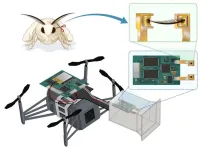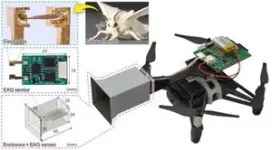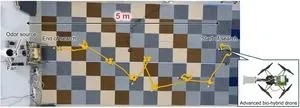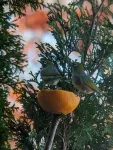(Press-News.org) Conventional drones use visual sensors for navigation. However, environmental conditions like dampness, low light, and dust can hinder their effectiveness, limiting their use in disaster-stricken areas. Researchers from Japan have developed a novel bio-hybrid drone by combining robotic elements with odor-sensing antennae from silkworm moths. Their innovation, which integrates the agility and precision of robots with biological sensory mechanisms, can enhance the applicability of drones in navigation, gas sensing, and disaster response.
Technological advances have led to the development of drones with diverse applications, including navigation, gas sensing, infrastructure and transportation, imaging, and disaster response. Conventional navigation systems in drones rely on visual sensors like thermal imaging and light detection and ranging (LiDAR). However, environmental conditions such as low light, dust, and moisture can compromise their function, highlighting the need for more versatile alternatives.
In nature, animals, birds, and insects have an inherent navigation system based on their sense of smell that helps them locate food sources, evade predators, and attract potential mates, thereby promoting their overall survival. Insects, in particular male moths, can detect windborne sex pheromones from distances that, in some cases, extend to several kilometers through a process known as odor-source localization.
Bio-hybrid drones that integrate these biological sensory mechanisms with advanced artificial machinery hold significant promise in overcoming the challenges associated with existing robotic technologies.
In this context, a team of researchers led by Associate Professor Daigo Terutsuki from the Department of Mechanical Engineering and Robotics, Faculty of Textile Science and Technology, Shinshu University, Japan, along with Associate Professor Toshiyuki Nakata and Chihiro Fukui from Chiba University, Japan, have used silkworm moth antennae to develop a novel bio-hybrid drone capable of odor sensing and tracking. This study was published online in the journal npj Robotics on February 5, 2025.
Explaining their motivation behind the study, Dr. Terutsuki says, “Our team is continuing to develop bio-hybrid drones that utilize living insect antennae as odor sensor elements. In this research, we strive to incorporate the dynamic movements and mechanisms of living organisms to dramatically enhance the performance of our odor-tracking drones. We initiated this study with the belief that these advancements will enable more effective odor detection and broaden applications in rescue operations.”
Previously, the researchers developed a bio-hybrid drone equipped with an electroantennography (EAG) sensor based on insect antennae with high sensitivity and specificity. However, its applications were limited by a short detection range of less than two meters. In the current study, the team has enhanced the primary version by further incorporating mechanisms that mimic the biological process in insects. Insects pause intermittently during the odor-tracking process to improve search precision. However, robotic odor-search models lack such pauses in their operation which may impact their range of detection.
To address this, the researchers introduced a “stepped rotation algorithm” that mimics insect pauses during odor sensing, significantly improving detection accuracy. They also redesigned the electrodes and EAG sensor to more effectively accommodate the structure of silkworm moth antennae. The seamless interface between the gain-modulable (responsive to electrical signal intensities) EAG sensor and the insect antennae significantly improved the performance and operability of the system.
Additionally, the team used a funnel-shaped enclosure to reduce airflow resistance and applied a conductive coating inside the enclosure to minimize noise interference from electrostatic charging. These modifications resulted in superior odor-source sensing under varied environmental conditions and odorant concentrations, with an effective detection range of up to 5 meters.
The diverse applicability of the odor-sensing bio-hybrid drone could potentially revolutionize gas leak detection in critical infrastructures, early fire detection, enhance public security at airports by detecting hazardous substances like drugs and explosives, and enable better disaster response by improving rescue operations.
This technology can be particularly useful in geographical regions that are more prone to natural disasters like earthquakes for rescue purposes. “Traditionally, search and rescue efforts have relied on manual visual searches due to the absence of a definitive technology capable of efficiently locating individuals in distress. The advanced bio-hybrid drone developed in this study has the potential to enable responders to rapidly locate survivors by tracking odors, ultimately saving more lives when every second counts.” Dr. Terutsuki concludes.
###
About Shinshu University
Shinshu University is a national university founded in 1949 and located nestling under the Japanese Alps in Nagano known for its stunning natural landscapes. Our motto, "Powered by Nature - strengthening our network with society and applying nature to create innovative solutions for a better tomorrow" reflects the mission of fostering promising creative professionals and deepening the collaborative relationship with local communities, which leads to our contribution to regional development by innovation in various fields. We’re working on providing solutions for building a sustainable society through interdisciplinary research fields: material science (carbon, fiber and composites), biomedical science (for intractable diseases and preventive medicine) and mountain science, and aiming to boost research and innovation capability through collaborative projects with distinguished researchers from the world. For more information visit https://www.shinshu-u.ac.jp/english/ or follow us on X (Twitter) @ShinshuUni for our latest news.
About Associate Professor Daigo Terutsuki from Shinshu University
Dr. Daigo Terutsuki is an Associate Professor in the Faculty of Textile Science and Technology at Shinshu University, Japan. His research specializes in bio-hybrid systems that integrate biological components with mechanical engineering to achieve functionalities beyond conventional methods. Currently, he is leading a project on odor-detecting flying robots—bio-hybrid drones that utilize insect antennae as highly sensitive sensor elements. His innovative work aims to develop these drones for use in search-and-rescue operations in disaster situations, pushing the boundaries of robotics and sensor technology.
END
Seizures in newborns are one of the most frequent acute neurological conditions among infants admitted to neonatal care units. A study published in Developmental Medicine & Child Neurology indicates that newborns experiencing such neonatal seizures face an elevated risk of developing epilepsy.
For the study, investigators analyzed data on all children born in Denmark between 1997 and 2018, with the goal of comparing the risk of epilepsy in children with and without neonatal seizures.
Among 1,294,377 children, the researchers identified 1,998 who experienced neonatal seizures. The cumulative risk of epilepsy was 20.4% among children with neonatal seizures compared with 1.15% among children ...
Although a woman’s ovaries produce the most estrogen, various types of estrogen are also synthesized throughout different tissues in the body, including the brain’s neurons. New research in The FEBS Journal indicates that such neuroestrogens help suppress appetite.
Knowing that the enzyme aromatase is important for the production of estrogens, investigators depleted or knocked out the gene encoding aromatase in mice, so that the animals were unable to synthesize estrogens in a systemic or body-wide manner. These mice demonstrated increased food intake and body weight compared with their aromatase-expressing counterparts. Restoring aromatase expression specifically ...
New research published in Health Economics indicates that a national prohibition of menthol cigarettes in the United States could increase the number of people who attempt to quit smoking but also support an illegal menthol cigarette market.
For the research, 639 adult menthol smokers made hypothetical choices between menthol and non-menthol cigarettes, menthol and non-menthol e-cigarettes, and attempting to quit. Participants were presented with situations where menthol cigarettes and menthol e-cigarettes were described as either legal, prohibited but available under-the-counter and online from retailers who continue ...
Results from the Systolic Blood Pressure Intervention Trial (SPRINT) have supported lower blood pressure targets among community-dwelling older adults with hypertension to reduce the risk of cardiovascular disease and early death, but intensive blood pressure lowering can also increase risks of developing acute kidney injury and experiencing dangerously low blood pressure. A recent analysis in the Journal of the American Geriatrics Society looked closely at the benefits and harms of intensive blood pressure lowering in patients with different characteristics.
The analysis found that nearly all older adults in SPRINT had a positive ...
Research published in New Phytologist provides insights into why the invasive plant Japanese knotweed is so successful at outcompeting native plants.
Japanese knotweed (Reynoutria japonica), which is native to eastern Asia and is a highly invasive plant species across Europe and North America, is known to damage infrastructure and ecosystems. By comparing growth and reproduction traits of introduced plants with native plants, investigators discovered that introduced plants had gained the ability to reproduce faster by clonal propagation, a method ...
The Chinese government is phasing in reforms for many technical standards that shape the products and services used by consumers around the world. While China has primarily depended on unilateral government authority for developing its standard system, the reforms would also incorporate market economies. New research published in Contemporary Economic Policy examined the impact of these reforms on corporate labor employment.
The study’s findings indicate that comprehensive standardization reform facilitates an increase in corporate labor employment by reducing transaction costs, enhancing operational efficiency, and improving the financing environment. The most profound impacts ...
Staffing reductions across U.S. federal health agencies—including the Department of Health and Human Services (HHS), Centers for Disease Control and Prevention (CDC), Food and Drug Administration (FDA), National Institutes of Health (NIH), and Agency for Healthcare Research and Quality (AHRQ)—pose a significant threat to public health, according to the Society for Healthcare Epidemiology of America (SHEA). The dismissal of thousands of staff is a massive loss of expertise and interruption ...
As global energy consumption continues to rise, buildings account for approximately 40% of total energy use, with nearly half of that dedicated to indoor thermal regulation (heating and cooling). Windows, being the primary pathway for energy exchange between the interior and exterior of buildings, contribute to 20-40% of energy loss. Developing energy-efficient smart windows that reduce energy consumption while maintaining natural lighting and aesthetic appeal has become a key strategy in sustainable building development.
Researchers from Nanjing University of ...
All humans need clean water to live. However, purifying water can be energy-intensive, so there is great interest in improving this process. Researchers at Tohoku University have reported a strategy using data-driven predictions coupled with precise synthesis to accelerate the development of single-atom catalysts (SACs) for more robust and efficient water purification.
SACs are one of the most crucial catalysts. They play a pivotal role in enhancing efficiency in diverse applications including chemical industries, energy conversion, and environmental processes. ...
New University of Otago – Ōtākou Whakaihu Waka research shows Aotearoa has been increasingly accepting new bird species from around the world since the start of the Ice Age, offering clues into future migration patterns.
Since the Ice Age drastically changed the Aotearoa landscape from widely forested to grass and shrubland, researchers set out to determine which of our living and recently extinct birds are a result of existing lineages that adapted to their environment tens of millions of years ago and which are the descendants of comparatively recent invaders.
Using mitogenome data from nearly all living and recently extinct New Zealand mainland bird species, researchers ...



